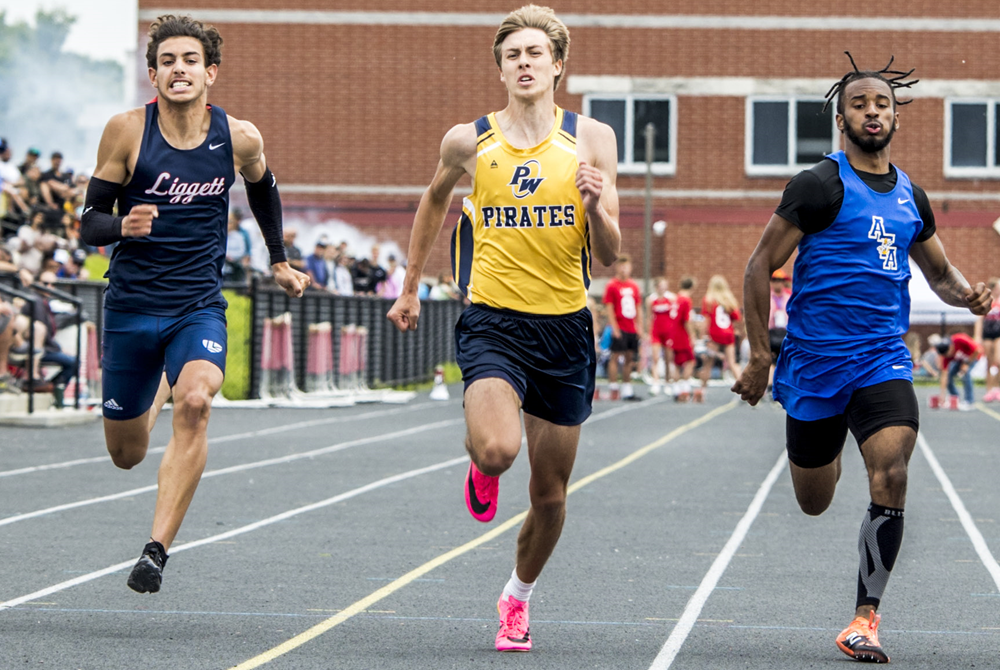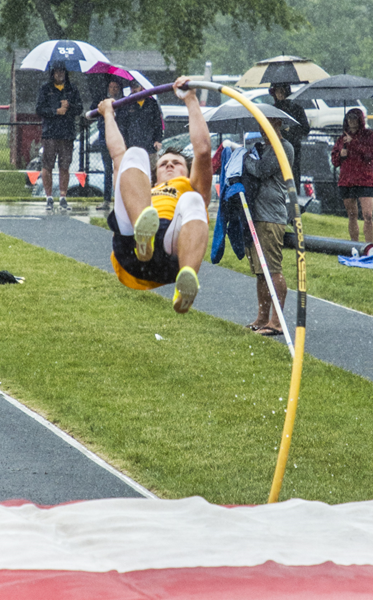
New Math: Division & Multiplication Problems
July 25, 2017
By Jack Roberts
MHSAA Executive Director
This is the second part in a series on MHSAA tournament classification, past and present, that will be published over the next two weeks. This series originally ran in this spring's edition of MHSAA benchmarks.
High school tournament classifications went viral before there was social media and most of us knew what “viral” meant.
Much as a virus infects computers today or has created epidemics of disease around the world for centuries, high school tournament classification – once introduced – tends to spread uncontrollably. Once started, it tends to keep expanding and rarely contracts.
While we are still some distance from providing every team a trophy as a result of expanding high school tournament classification across the country, there is criticism nevertheless that we are headed in that direction – a philosophy which is supposed to exist only in local youth sports for our youngest children.
Michigan could be blamed for all this. Michigan is generally accepted as the first state to provide different classifications for season-ending tournaments for different sized schools. It started a century ago. Today, every state has various classifications for its tournaments in most if not all sports. And it is a bit ironic that Michigan – creator of the classification chaos – more than most other states has kept the number of tournament classes or divisions under control.
Yes, there is evidence that tournament classifications have expanded over the years in Michigan, especially with the relatively recent introduction of tournaments in football and the late 1990s’ move from classes to divisions in most MHSAA tournaments. But the MHSAA Representative Council has held true to its word when it expanded the playoffs for football from four classes to eight divisions: this is needed because of unique factors of football, factors that exist in no other sport; and all other sports should be capped at a maximum of four classes or divisions.
Kentucky is the preeminent defender of single-class basketball. All of its 276 high schools compete for the single state championship for each gender. In Indiana, there are still open wounds from its move in 1998 from one to four classes for its 400 schools in basketball.
Multi-class tournaments have tended to increase the number of non-public school champions, which some states are trying to lower through enrollment “multipliers,” and also tend to increase the number of repeat champions, which some states are trying to affect with “success factors” which lift smaller schools into classifications for larger schools if they take home too many trophies.
While there is considerable evidence that state tournaments do as much bad as good for educational athletics, state associations persist in providing postseason tournaments because, on balance, the experiences are supposed to be good for student-athletes. And once we reach that conclusion it is just a small leap to believe that if the tournaments are good for a few, they must be better for more – which leads to creating more and more tournament classifications. One becomes two classes, then three, then four and so forth.
While the argument is that more classifications or divisions provides more students with opportunities to compete and win, it is undeniable that the experience changes as the number of tournament classifications expands. It is not possible for state associations to provide the same level of support when tournament classifications expand to multiple venues playing simultaneously. For example, there is less audio and video broadcast potential at each venue, and less media coverage to each venue. Focus is diluted and fans diminished at each championship.
No one can argue reasonably that today's two-day MHSAA Football Finals of eight championship games has the same pizazz as the one-day, four-games event conducted prior to 1990.
In some states the number of divisions has grown so much that it is difficult to see much difference between the many season-ending state championship games and a regular-season event in the same sport.
It is a balancing act. And Michigan has been studying that balance longer than any other state, and charting a steadier course than most.
Addition by Division
The shift to Divisions for MHSAA Tournament play in numerous sports has added up to a greater number of champions for teams and individuals across the state. Following are the sports currently employing a divisional format, and the procedures for determining enrollment and classification.
In 23 statewide or Lower Peninsula tournaments, schools which sponsor the sport are currently divided into nearly equal divisions. They are:
- Baseball - 4 Divisions
- Boys Bowling - 4 Divisions
- Girls Bowling - 4 Divisions
- Girls Competitive Cheer - 4 Divisions
- LP Boys Cross Country - 4 Divisions
- LP Girls Cross Country - 4 Divisions
- LP Boys Golf - 4 Divisions
- LP Girls Golf - 4 Divisions
- Ice Hockey - 3 Divisions
- Boys Lacrosse - 2 Divisions
- Girls Lacrosse - 2 Divisions
- Boys Skiing - 2 Divisions
- Girls Skiing - 2 Divisions
- LP Boys Soccer - 4 Divisions LP
- Girls Soccer - 4 Divisions
- Girls Softball - 4 Divisions
- LP Boys Swimming & Diving - 3 Divisions
- LP Girls Swimming & Diving - 3 Divisions
- LP Boys Tennis - 4 Divisions
- LP Girls Tennis - 4 Divisions
- LP Boys Track & Field - 4 Divisions
- LP Girls Track & Field - 4 Divisions
- Wrestling - 4 Divisions
Lists of schools for each division of these 23 tournaments are posted on MHSAA.com approximately April 1. Listings of schools in Upper Peninsula tournaments for their sports are also posted on MHSAA.com. The lists are based on school memberships and sports sponsorships in effect or anticipated for the following school year, as known to the MHSAA office as of a date in early March.
In football, the 256 schools which qualify for MHSAA 11-player playoffs are placed in eight equal divisions annually on Selection Sunday. Beginning in 2017, the 8-player divisions will be determined in a like manner on Selection Sunday as well, with 32 qualifying schools placed in two divisions.
Schools have the option to play in any higher division in one or more sports for a minimum of two years.
The deadlines for "opt-ups" are as follows:
- Applications for fall sports must be submitted by April 15
- Applications for winter sports must be submitted by Aug. 15
- Applications for spring sports must be submitted by Oct. 15
Subsequent to the date of these postings for these tournaments, no school will have its division raised or lowered by schools opening or closing, schools adding or dropping sports, schools exercising the option to play in a higher division, or approval or dissolution of cooperative programs.
When the same sport is conducted for boys and girls in the same season (e.g., track & field and cross country), the gender that has the most sponsoring schools controls the division breaks for both genders.

Smith Sets Tone as Multi-Talented Pewamo-Westphalia Ascends Again
By
Dean Holzwarth
Special for MHSAA.com
June 1, 2024
KENT CITY – Trevor Smith set the tone early for the Pewamo-Westphalia boys track & field team Saturday at Kent City.
The junior sprinter earned a narrow win in the 100 to collect early points that would prove beneficial in the Pirates’ pursuit of their latest Lower Peninsula Division 3 championship.
“It was a big win right away in the beginning, and it helped put us in a good position,” Smith said. “It was a big emotional shift, and it was unreal.
“I didn’t really expect it, but it was a big help toward our team with points. I just missed winning last year, so to come back and win it meant a lot.”
Pewamo-Westphalia kept its early advantage throughout and hung on in the end to capture the title. The Pirates, last year’s runners-up, recorded 49 points to clip second-place Clare by four points. Detroit Edison was third with 32 points.
P-W senior Gavin Nurenberg repeated in the shot put (60-02), while senior Collin Farmer added a pair of top-4 finishes in the distance events.
“Our boys had a really nice season, but this was always the focus from Day 1,” Pirates coach Scott Werner said. “We felt we had the pieces in place when we got out of Regionals, and we were just excited to attack the day.
“We are the type of program where we are good in quite a few events. We don't rely on one person. We set the tone early with unexpected points in the 3,200 relay, and it built from there.”
 Farmer finished runner-up in the 3,200 and fourth in the 1,600.
Farmer finished runner-up in the 3,200 and fourth in the 1,600.
“There are not a lot of teams that have good guys in the field, sprints and distance, so I think that brings a lot of peace to the team,” Farmer said. “We knew that we could trust each other, and not one person had to take control.”
Senior Dalton Brown also provided a lift with a personal record en route to a third-place finish in the shot put.
“I challenged each of the separate groups to go out and score a minimum of 15 points,” Werner said. “We had a plan and an approach for every single event, and they trusted the process and executed at the highest level. I’m proud of them.”
Clare made a late push with a strong showing in the relays, while also receiving a boost from senior Brad White. He cruised to a win in the 800 with a new personal-best time and also was part of the winning 1,600 relay.
“Honestly, I didn't expect this,” White said. “I came into today pressure-free. I’ve already accomplished everything I could ever want in a season, and I'm just as happy as I can be to come out here and do something special, especially in my last high school race. I’m proud of my team and my PR.”
North Muskegon senior Jerry Wiegers repeated in the 400 by edging Geoffrey McBurrow of Detroit Edison. Wiegers also won the 200.
“There was a lot of pressure (to repeat), and I was worried on the whole ride here that I was going to screw up and I was going to have to hand the title to someone else,” Wiegers said. “But when I finally passed the finish line and I won, I was like, ‘I did this again, in my final year in high school.’ It was a good way to cap off my career.”
Coloma senior Boden Genovese (1,600) and Grayling senior Drew Moore (3,200) won the distance races, and Napoleon senior Holden Van Poppel (110) and Elk Rapids junior Max Ward (300) were hurdles champions. Standish-Sterling (400), Edison (800) and Traverse City St. Francis (3,200) also won relays. Lawton junior Mason Mayne (discus), Ovid-Elsie junior Tryce Tokar (pole vault) and Clare sophomore Conan Weeks (long jump) were other field event winners. Grosse Pointe Woods University Liggett senior Jake Juip (100 and 200), Montague junior Wyatt Fairchild (400) and Perry senior Alec Chapman (shot put) won the adaptive event championships.
PHOTOS (Top) Pewamo-Westphalia's Trevor Smith, center, edges Dearborn Advanced Technology's Cobey Cureton and University Liggett's Santino Cicarella, among others, in the 100 on Saturday. (Middle) Ovid-Elsie's Tryce Tokar attempts a vault amid the rainy conditions. (Click for more from Jamie McNinch/RunMichigan.com.)

